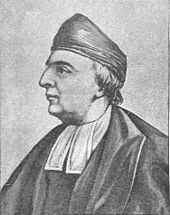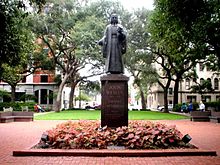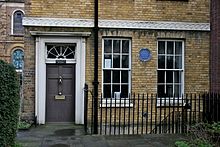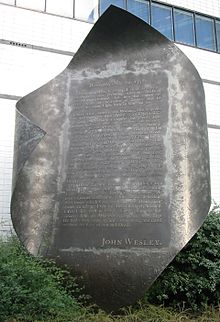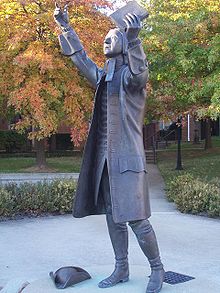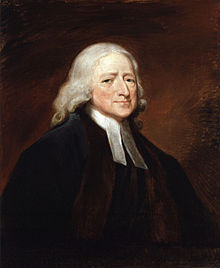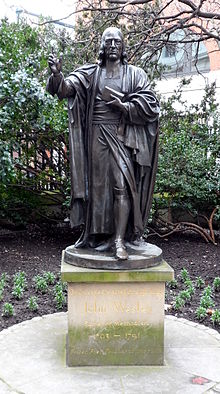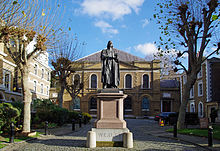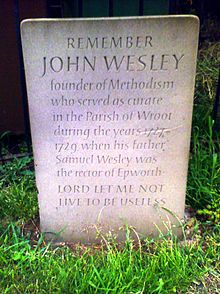
John Wesley
Background Information
SOS believes education gives a better chance in life to children in the developing world too. With SOS Children you can choose to sponsor children in over a hundred countries
| John Wesley | |
|---|---|
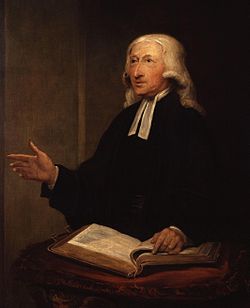 John Wesley by William Hamilton |
|
| Born | 28 June [ O.S. 17 June] 1703 Epworth, Lincolnshire, England |
| Died | 2 March 1791 (aged 87) London, England |
| Nationality | British |
| Alma mater | Christ Church, Oxford |
| Occupation | Preacher and theologian |
| Known for | Founder of the Methodist movement |
| Style | The Reverend |
| Religion | Christian (An Anglican priest his whole life but developed Methodist theology) |
| Spouse(s) | Mary Wesley ( née Vazeille) |
| Parents | Samuel and Susanna Wesley |
| Signature | |
John Wesley (pron.: / ˈ w ɛ z l ɪ /; 28 June [ O.S. 17 June] 1703 – 2 March 1791) was an Anglican cleric and Christian theologian. Wesley is largely credited, along with his brother Charles Wesley, as founding the Methodist movement which began when he took to open-air preaching in a similar manner to George Whitefield. In contrast to George Whitefield's Calvinism, Wesley embraced the Arminian doctrines that were dominant in the 18th-century Church of England. Methodism in both forms was a highly successful evangelical movement in the United Kingdom, which encouraged people to experience Jesus Christ personally.
Wesley helped to organise and form societies of Christians throughout Great Britain, North America and Ireland as small groups that developed intensive, personal accountability, discipleship and religious instruction among members. His great contribution was to appoint itinerant, unordained preachers who travelled widely to evangelise and care for people in the societies.
Under Wesley's direction, Methodists became leaders in many social issues of the day, including the prison reform and abolitionism movements. Wesley's contribution as a theologian was to propose a system of opposing theological stances. His greatest theological achievement was his promotion of what he termed " Christian Perfection", or holiness of heart and life. Wesley held that, in this life, Christians could come to a state in which the love of God, or perfect love, reigned supreme in their hearts. His evangelical theology, especially his understanding of Christian perfection, was firmly grounded in his sacramental theology. He continually insisted on the general use of the means of grace ( prayer, scripture, meditation, Eucharist, etc.) as the means by which God sanctifies and transforms the believer.
Throughout his life Wesley remained within the Established Church and insisted that his movement was well within the bounds of the Anglican tradition. His maverick use of church policy put him at odds with many within the Church of England, though toward the end of his life he was widely respected and referred to as "the best loved man in England."
Early life
John Wesley was born in 1703 in Epworth, 23 miles (37 km) northwest of Lincoln, the fifteenth child of Samuel Wesley and his wife Susanna Wesley (née Annesley). His father was a graduate of the University of Oxford and a Church of England rector. In 1689 Samuel had married Susanna, twenty-fifth child of Samuel Annesley, a Dissenting minister. Wesley's parents had both become members of the established Church of England early in adulthood. Susanna bore Samuel Wesley nineteen children, but only ten lived. In 1696 Wesley's father was appointed the rector of Epworth.
At the age of five, Wesley was rescued from the burning rectory. This escape made a deep impression on his mind and he regarded himself as providentially set apart, as a "brand plucked from the burning" quoting Zechariah 3:2. As in many families at the time, Wesley's parents gave their children their early education. Each child, including the girls, was taught to read as soon as they could walk and talk. In 1714, at age 11, Wesley was sent to the Charterhouse School in London (under the mastership of John King from 1715), where he lived the studious, methodical and—for a while—religious life in which he had been trained at home.
Oxford and Savannah, Georgia
In June 1720, Wesley entered Christ Church, Oxford. He was ordained deacon in 1725 and elected fellow of Lincoln College in the following year. He received his Master of Arts in 1727. He was his father's curate for two years, and then returned to Oxford to fulfil his functions as fellow..
In the year of his ordination he read Thomas a Kempis and Jeremy Taylor, and began to seek the religious truths which underlay the great revival of the 18th century. The reading of Law's Christian Perfection and A Serious Call to a Devout and Holy Life gave him, he said, a sublimer view of the law of God; and he resolved to keep it, inwardly and outwardly, as sacredly as possible, believing that in obedience he would find salvation. He pursued a rigidly methodical and abstemious life, studied the Scriptures, and performed his religious duties diligently, depriving himself so that he would have alms to give. He began to seek after holiness of heart and life.
The year of his return to Oxford (1729) marks the beginning of the rise of Methodism. The Holy Club was formed by John's younger brother, Charles Wesley, and some fellow students, including George Whitefield. The holy club met weekly and they systematically set about living a holy life. They were branded as "Methodist" by students at Oxford who derided the methodical way they ordered their lives.
On 14 October 1735, Wesley and his brother Charles sailed on The Simmonds from Gravesend, Kent for Savannah in the Province of Georgia in the American colonies at the request of James Oglethorpe, who had founded the colony in 1733 on behalf of the Trustees for the Establishment of the Colony of Georgia in America. Oglethorpe wanted Wesley to be the minister of the newly formed Savannah parish, a new town laid out in accordance with the famous Oglethorpe Plan.
It was on the voyage to the colonies that the Wesleys first came into contact with Moravian settlers. Wesley was influenced by their deep faith and spirituality rooted in pietism. At one point in the voyage a storm came up and broke the mast off the ship. While the English panicked, the Moravians calmly sang hymns and prayed. This experience led Wesley to believe that the Moravians possessed an inner strength which he lacked. The deeply personal religion that the Moravian pietists practised heavily influenced Wesley's theology of Methodism.
They reached Savannah on 8 February 1736, where Wesley saw Oglethorpe's offer as an opportunity to spread Christianity to the Native Americans in the colony. Wesley's mission, however, was unsuccessful, and he and his brother Charles were constantly beset by troubles in the colonies.
On top of his struggles with teaching, Wesley found disaster in his relations with Sophia Hopkey, a woman who had journeyed across the Atlantic on the same ship as Wesley. Wesley and Hopkey became romantically involved, but Wesley abruptly broke off the relationship on the advice of a Moravian minister in whom he confided. Hopkey contended that Wesley had promised to marry her and therefore had gone back on his word in breaking off the relationship. Wesley's problems came to a head when he refused Hopkey communion. She and her new husband, William Williamson, filed suit against Wesley.
Wesley stood trial and faced the accusations made by Hopkey. The proceedings ended in a mistrial, but Wesley's reputation had already been tarnished too greatly and he made it known that he intended to return to England. Williamson again tried to raise charges against Wesley to prevent him from leaving the colony, but he managed to escape back to England. He was left exhausted by the whole experience. His mission to Georgia contributed to a lifelong struggle with self-doubt.
Conversion and open-air preaching
Wesley returned to England depressed and beaten. It was at this point that he turned to the Moravians. Both he and Charles received counsel from the young Moravian missionary Peter Boehler, who was temporarily in England awaiting permission to depart for Georgia himself. John's famous "Aldersgate experience" of 24 May 1738, at a Moravian meeting in Aldersgate Street, London, in which he heard a reading of Martin Luther's preface to the Epistle to the Romans, and penned the now famous lines "I felt my heart strangely warmed", revolutionised the character and method of his ministry. The previous week he had been highly impressed by the sermon of John Heylyn, whom he was assisting in the service at St Mary-le-Strand, an occasion followed immediately by news of the death of his brother Samuel. A few weeks later, Wesley preached a sermon on the doctrine of personal salvation by faith, which was followed by another, on God's grace "free in all, and free for all."
Though his understanding of both justification and the assurance varied throughout his life, Wesley never stopped preaching the importance of faith for salvation and the witness of God's Spirit with the belief that one was, indeed, a child of God.
Wesley allied himself with the Moravian society in Fetter Lane. In 1738 he went to Herrnhut, the Moravian headquarters in Germany, to study. On his return to England, Wesley drew up rules for the "bands" into which the Fetter Lane Society was divided and published a collection of hymns for them. He met frequently with this and other religious societies in London but did not preach often in 1738, because most of the parish churches were closed to him.
Wesley's Oxford friend, the evangelist George Whitefield, was also excluded from the churches of Bristol upon his return from America. Going to the neighbouring village of Kingswood, in February 1739, Whitefield preached in the open air to a company of miners. Later he preached in Whitefield's Tabernacle. Wesley hesitated to accept Whitefield's call to copy this bold step. Overcoming his scruples, he preached the first time at Whitefield's invitation sermon in the open air, near Bristol, in April 1739.
Wesley was unhappy about the idea of field preaching as he believed the Anglican Church had much to offer in its practice. Earlier in his life he would have thought that such a method of saving souls was "almost a sin." Wesley recognised the open-air services were successful in reaching men and women who would not enter most churches. From then on he took the opportunities to preach wherever an assembly could be brought together, more than once using his father's tombstone at Epworth as a pulpit. Wesley continued for fifty years – entering churches when he was invited, and taking his stand in the fields, in halls, cottages, and chapels, when the churches would not receive him.
Late in 1739 Wesley broke with the Moravians in London. Wesley had helped them organise the Fetter Lane Society, and those converted by his preaching and that of his brother and Whitefield had become members of their bands. But he believed they fell into heresy by supporting quietism, so he decided to form his own followers into a separate society. "Thus," he wrote, "without any previous plan, began the Methodist Society in England." He soon formed similar societies in Bristol and Kingswood, and wherever Wesley and his friends made converts.
Persecutions; lay preaching
From 1739 onward, Wesley and the Methodists were persecuted by clergy and magistrates for various reasons. Though Wesley had been ordained an Anglican priest, many other Methodist leaders had not received ordination. And for his own part, Wesley flouted many regulations of the Church of England concerning parish boundaries and who had authority to preach. This was seen as a social threat that disregarded institutions. Clergy attacked them in sermons and in print, and at times mobs attacked them. Wesley and his followers continued to work among the neglected and needy. They were denounced as promulgators of strange doctrines, fomenters of religious disturbances; as blind fanatics, leading people astray, claiming miraculous gifts, attacking the clergy of the Church of England, and trying to re-establish Catholicism.
Wesley felt that the church failed to call sinners to repentance, that many of the clergy were corrupt, and that people were perishing in their sins. He believed he was commissioned by God to bring about revival in the church, and no opposition, persecution, or obstacles could prevail against the divine urgency and authority of this commission. The prejudices of his high-church training, his strict notions of the methods and proprieties of public worship, his views of the apostolic succession and the prerogatives of the priest, even his most cherished convictions, were not allowed to stand in the way.
Unwilling that people should perish in their sins and unable to reach them from church pulpits, following the example set by George Whitefield, Wesley began field preaching. Seeing that he and the few clergy co-operating with him could not do the work that needed to be done, he was led, as early as 1739, to approve local preachers. He evaluated and approved men who were not ordained by the Anglican Church to preach and do pastoral work. This expansion of lay preachers was one of the keys of the growth of Methodism.
Chapels and organisations
As his societies needed houses to worship in, Wesley began to provide chapels, first in Bristol at the New Room, then in London and elsewhere. The Bristol chapel (1739) was at first in the hands of trustees. A large debt was contracted, and Wesley's friends urged him to keep it under his own control, so the deed was cancelled and he became sole trustee. Following this precedent, all Methodist chapels were committed in trust to him until by a "deed of declaration", all his interests in them were transferred to a body of preachers called the "Legal Hundred".
When disorder arose among some members of the societies, Wesley adopted giving tickets to members, with their names written by his own hand. These were renewed every three months. Those deemed unworthy did not receive new tickets and dropped out of the society without disturbance. The tickets were regarded as commendatory letters.
When the debt on a chapel became a burden, it was proposed that one in twelve members should collect offerings regularly from the eleven allotted to him. Out of this grew the Methodist class-meeting system in 1742. In order to keep the disorderly out of the societies, Wesley established a probationary system. He undertook to visit each society regularly in what became the quarterly visitation, or conference. As the number of societies increased, Wesley could not keep personal contact, so in 1743 he drew up a set of "General Rules" for the "United Societies". These were the nucleus of the Methodist Discipline, still the basis.
General Rules: It is therefore expected of all who continue therein that they should continue to evidence their desire of salvation,
First: By doing no harm, by avoiding evil of every kind . . . ;
Second: By . . . doing good of every possible sort, and, as far as possible, to all . . . ;
Third: By attending upon all the ordinances of God
As the number of preachers and preaching-places increased, doctrinal and administrative matters needed to be discussed; so John and Charles Wesley, along with four other clergy and four lay preachers, met for consultation in London in 1744. This was the first Methodist conference; subsequently, the conference (with Wesley as its president) became the ruling body of the Methodist movement. Two years later, to help preachers work more systematically and societies receive services more regularly, Wesley appointed "helpers" to definitive circuits. Each circuit included at least thirty appointments a month. Believing that the preacher's efficiency was promoted by his being changed from one circuit to another every year or two, Wesley established the "itinerancy" and insisted that his preachers submit to its rules. When, in 1788, some objected to the frequent changes, Wesley wrote, "For fifty years God has been pleased to bless the itinerant plan, the last year most of all. It must not be altered til I am removed, and I hope it will remain til our Lord comes to reign on earth."
Ordination of ministers
As the societies multiplied, they adopted the elements of an ecclesiastical system. The divide between Wesley and the Church of England widened. The question of division from the Church of England was urged by some of his preachers and societies, but most strenuously opposed by his brother Charles. Wesley refused to leave the Church of England, believing that Anglicanism was "with all her blemishes, [...] nearer the Scriptural plans than any other in Europe". In 1745 Wesley wrote that he would make any concession which his conscience permitted, in order to live in peace with the clergy. He could not give up the doctrine of an inward and present salvation by faith itself. He would not stop preaching, nor dissolve the societies, nor end preaching by lay members. As a cleric of the established church he had no plans to go further. "We dare not", he said, "administer baptism or the Lord's Supper without a commission from a bishop in the apostolic succession."
When in 1746 Wesley read Lord King on the primitive church, he became convinced that the concept of apostolic succession in Anglicanism was a "fable". He wrote that he was "a scriptural episkopos as much as many men in England."
Many years later Edward Stillingfleet's Irenicon led him to decide that ordination could be valid when performed by a presbyter rather than a bishop. Nevertheless, many believe that Wesley was consecrated a bishop in 1763 by Erasmus of Arcadia, and that Wesley could not openly announce his episcopal consecration without incurring the penalty of the Præmunire Act.
In 1784, he believed he could not longer wait for the Bishop of London to ordain someone for the American Methodists, who were without the sacraments after the American War of Independence. The Church of England had been disestablished in the United States, where it had been the state church in most of the southern colonies. The Church of England had not yet appointed a United States bishop to what would become the Protestant Episcopal Church in America. Wesley ordained Thomas Coke by the laying on of hands although Coke was already a priest in the Church of England. Wesley appointed him to be superintendent of Methodists in the United States. He also ordained Richard Whatcoat and Thomas Vasey as presbyters. Whatcoat and Vasey sailed to America with Coke. Wesley intended that Coke and Asbury (whom Coke ordained) should ordain others in the newly founded Methodist Episcopal Church in the United States.
His brother Charles grew alarmed and begged Wesley to stop before he had "quite broken down the bridge" and not embitter his [Charles'] last moments on earth, nor "leave an indelible blot on our memory." Wesley replied that he had not separated from the church, nor did he intend to, but he must and would save as many souls as he could while alive, "without being careful about what may possibly be when I die." Although Wesley rejoiced that the Methodists in America were free, he advised his English followers to remain in the established church, and he himself died within it.
Doctrines and theology
The 20th century Wesley scholar Albert Outler argued in his introduction to the 1964 collection John Wesley that Wesley developed his theology by using a method that Outler termed the Wesleyan Quadrilateral. In this method, Wesley believed that the living core of the Christian faith was revealed in Scripture; and the Bible was the sole foundational source of theological or doctrinal development. The centrality of Scripture was so important for Wesley that he called himself "a man of one book"—meaning the Bible—although he was well-read for his day. However, he believed that doctrine had to be in keeping with Christian orthodox tradition. So, tradition was considered the second aspect of the Quadrilateral.
Wesley contended that a part of the theological method would involve experiential faith. In other words, truth would be vivified in personal experience of Christians (overall, not individually), if it were really truth. And every doctrine must be able to be defended rationally. He did not divorce faith from reason. Tradition, experience and reason, however, were subject always to Scripture, Wesley argued, because only there is the Word of God revealed "so far as it is necessary for our salvation."
The doctrines which Wesley emphasised in his sermons and writings are prevenient grace, present personal salvation by faith, the witness of the Spirit, and sanctification. Prevenient grace was the theological underpinning of his belief that all persons were capable of being saved by faith in Christ. Unlike the Calvinists of his day, Wesley did not believe in predestination, that is, that some persons had been elected by God for salvation and others for damnation. He understood that Christian orthodoxy insisted that salvation was only possible by the sovereign grace of God. He expressed his understanding of humanity's relationship to God as utter dependence upon God's grace. God was at work to enable all people to be capable of coming to faith by empowering humans to have actual existential freedom of response to God.
Wesley defined the witness of the Spirit as: "an inward impression on the soul of believers, whereby the Spirit of God directly testifies to their spirit that they are the children of God." He based this doctrine upon certain Biblical passages (see Romans 8:15–16 as an example). This doctrine was closely related to his belief that salvation had to be "personal." In his view, a person must ultimately believe the Good News for himself or herself; no one could be in relation to God for another.
Sanctification he described in 1790 as the "grand depositum which God has lodged with the people called `Methodists'." Wesley taught that sanctification was obtainable after justification by faith, between justification and death. He did not contend for "sinless perfection"; rather, he contended that a Christian could be made "perfect in love". (Wesley studied Eastern Orthodoxy and particularly the doctrine of Theosis). This love would mean, first of all, that a believer's motives, rather than being self-centred, would be guided by the deep desire to please God. One would be able to keep from committing what Wesley called, "sin rightly so-called." By this he meant a conscious or intentional breach of God's will or laws. A person could still be able to sin, but intentional or wilful sin could be avoided.
Secondly, to be made perfect in love meant, for Wesley, that a Christian could live with a primary guiding regard for others and their welfare. He based this on Christ's quote that the second great command is "to love your neighbour as you love yourself." In his view, this orientation would cause a person to avoid any number of sins against his neighbour. This love, plus the love for God that could be the central focus of a person's faith, would be what Wesley referred to as "a fulfilment of the law of Christ."
Wesley believed that this doctrine should be constantly preached, especially among the people called Methodists. In fact, he contended that the purpose of the Methodist movement was to "spread scriptural holiness across England."
Advocacy of Arminianism
Wesley entered controversies as he tried to enlarge church practice. The most notable of his controversies was that on Calvinism. His father was of the Arminian school in the church. Wesley came to his own conclusions while in college and expressed himself strongly against the doctrines of Calvinistic election and reprobation.
Whitefield inclined to Calvinism. In his first tour in America, he embraced the views of the New England School of Calvinism. When in 1739 Wesley preached a sermon on Freedom of Grace, attacking the Calvinistic understanding of predestination as blasphemous, as it represented "God as worse than the devil," Whitefield asked him not to repeat or publish the discourse, as he did not want a dispute. Wesley published his sermon anyway. Whitefield was one of many who responded. The two men separated their practice in 1741. Wesley wrote that those who held to unlimited atonement did not desire separation, but "those who held 'particular redemption' would not hear of any accommodation."
Whitefield, Harris, Cennick, and others, became the founders of Calvinistic Methodism. Whitefield and Wesley, however, were soon back on friendly terms, and their friendship remained unbroken although they travelled different paths. When someone asked Whitefield if he thought he would see Wesley in heaven, Whitefield replied, "I fear not, for he will be so near the eternal throne and we at such a distance, we shall hardly get sight of him." W. Wiersbe, Wycliffe Handbook of Preaching and Preachers, Moody Press, 1984, p. 255.
In 1770 the controversy broke out anew with violence and bitterness, as people's view of God related to their views of men and their possibilities. Augustus Montague Toplady, Rowland, Richard Hill, and others were engaged on the one side, and Wesley and Fletcher on the other. Toplady was editor of The Gospel Magazine, which had articles covering the controversy.
In 1778 Wesley began the publication of The Arminian Magazine, not, he said, to convince Calvinists, but to preserve Methodists. He wanted to teach the truth that "God willeth all men to be saved." A "lasting peace" could be secured in no other way.
His system of thought has become known as Wesleyan Arminianism, the foundations of which were laid by Wesley and Fletcher.
Support for abolitionism
Later in his ministry Wesley was a keen abolitionist. He spoke out and wrote against the slave trade. He published a pamphlet on slavery titled Thoughts Upon Slavery, (1774). To quote from one of his tracts against the slave trade: "Liberty is the right of every human creature, as soon as he breathes the vital air; and no human law can deprive him of that right which he derives from the law of nature". Wesley was a friend of John Newton and William Wilberforce who were also influential in the abolition of slavery in Britain.
Personality and activities
John Wesley travelled generally on horseback, preaching two or three times each day. Stephen Tomkins writes that he "rode 250,000 miles, gave away 30,000 pounds, ... and preached more than 40,000 sermons[.]"
He formed societies, opened chapels, examined and commissioned preachers, administered aid charities, prescribed for the sick, helped to pioneer the use of electric shock for the treatment of illness, superintended schools and orphanages, and received at least £20,000 for his publications but used little of it for himself.
After attending a performance in Bristol Cathedral in 1758, Wesley said: "I went to the cathedral to hear Mr. Handel's Messiah. I doubt if that congregation was ever so serious at a sermon as they were during this performance. In many places, especially several of the choruses, it exceeded my expectation."
Once he had a dream, which was well known as Wesley's Dream and published f. i. in the 19th century in The British Friend.
He is described as below medium height, well proportioned, strong, with a bright eye, a clear complexion, and a saintly, intellectual face. Wesley married very unhappily at the age of forty-eight to a widow, Mary Vazeille, and had no children. Vazeille left him fifteen years later, to which Wesley wryly reported in his journal, "I did not forsake her, I did not dismiss her, I will not recall her."
In 1770, at the death of George Whitefield, Wesley wrote a memorial sermon which praised Whitefield's admirable qualities and acknowledged the two men's differences: "There are many doctrines of a less essential nature ... In these we may think and let think; we may ' agree to disagree.' But, meantime, let us hold fast the essentials..." Wesley was the first to put the phrase 'agree to disagree' in print.
Wesley died on March 2nd 1791, in his eighty-seventh year. As he lay dying, his friends gathered around him, Wesley grasped their hands and said repeatedly, "Farewell, farewell." At the end, he said "The best of all is, God is with us", lifted his arms and raised his feeble voice again, repeating the words, "The best of all is, God is with us."
Wesley was entombed at Wesley's Chapel, which he built in Greater London, in England. The site also is now both a place of worship and a visitor attraction, incorporating the Museum of Methodism and John Wesley's House.
Because of his charitable nature he died poor, leaving as the result of his life's work 135,000 members and 541 itinerant preachers under the name "Methodist". It has been said that "when John Wesley was carried to his grave, he left behind him a good library of books, a well-worn clergyman's gown" and the Methodist Church.
Literary work
Wesley was a logical thinker and expressed himself clearly, concisely and forcefully in writing. His written sermons are characterised by spiritual earnestness and simplicity. They are doctrinal but not dogmatic. His Notes on the New Testament (1755) are enlightening. Both the Sermons (about 140) and the Notes are doctrinal standards. Wesley was a fluent, powerful and effective preacher. He usually preached spontaneously and briefly, though occasionally at great length.
As an organiser, a religious leader and a statesman, he was eminent. He knew how to lead and control men to achieve his purposes. He used his power, not to provoke rebellion, but to inspire love. His mission was to spread "Scriptural holiness"; his means and plans were such as Providence indicated. The course thus mapped out for him he pursued with a determination from which nothing could distract him.
Wesley's prose Works were first collected by himself (32 vols., Bristol, 1771–74, frequently reprinted in editions varying greatly in the number of volumes). His chief prose works are a standard publication in seven octavo volumes of the Methodist Book Concern, New York. The Poetical Works of John and Charles, ed. G. Osborn, appeared in 13 vols., London, 1868–72.
In addition to his Sermons and Notes are his Journals (originally published in 20 parts, London, 1740–89; new ed. by N. Curnock containing notes from unpublished diaries, 6 vols., vols. i.-ii., London and New York, 1909–11); The Doctrine of Original Sin (Bristol, 1757; in reply to Dr. John Taylor of Norwich); "An Earnest Appeal to Men of Reason and Religion (originally published in three parts; 2d ed., Bristol, 1743), an elaborate defence of Methodism, describing the evils of the times in society and the church; a Plain Account of Christian Perfection (1766).
Wesley adapted the Book of Common Prayer for use by American Methodists. In his Watch Night service, he made use of a pietist prayer now generally known as the Wesley Covenant Prayer, perhaps his most famous contribution to Christian liturgy. He also was a noted hymn-writer, translator and compiler of a hymnal
In spite of the proliferation of his literary output, Wesley was challenged for plagiarism for borrowing heavily from an essay by Samuel Johnson, publishing in March 1775. Initially denying the charge, Wesley later recanted and apologised officially.
Legacy
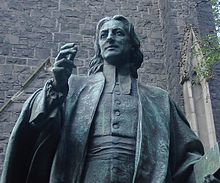
Wesley's teachings, known as Wesleyanism, provided the seeds for the modern Methodist movement, the Holiness movement, Pentecostalism, the Charismatic Movement, and Neo-charismatic churches, which encompass numerous denominations across the world. In addition, he refined Arminianism with a strong evangelical emphasis on the Reformed doctrine of justification by faith.
Wesley continues to be the primary theological interpreter for Methodists the world over; the largest bodies being the United Methodist Church, the Methodist Church of Great Britain and the African Methodist Episcopal Church. Wesleyan teachings also serve as a basis for the holiness movement, which includes denominations like the Wesleyan Church, the Free Methodist Church, the Church of the Nazarene, the Christian and Missionary Alliance, and several smaller groups, and from which Pentecostalism and parts of the charismatic movement are offshoots. Wesley's call to personal and social holiness continues to challenge Christians who attempt to discern what it means to participate in the Kingdom of God.
He is commemorated in the Calendar of Saints of the Evangelical Lutheran Church in America on 2 March with his brother Charles. The Wesley brothers are also commemorated on 3 March in the Calendar of Saints of the Episcopal Church and on 24 May in the Anglican calendar.
Wesley's legacy is preserved in Kingswood School, which he founded in 1748 in order to educate the children of the growing number of Methodist preachers. Also, one of the four form houses at the St Marylebone Church of England School, London, is named after John Wesley.
He was recently listed at 50 on the BBC's list of the 100 Greatest Britons.
In 1831, Wesleyan University in Middletown, Connecticut was the first institution of higher education in the United States to be named after Wesley. The now-secular institution was founded as an all-male Methodist college. About twenty unrelated colleges and universities in the U.S. were subsequently named after him.
In film
In 1954 the Radio and Film Commission of the Methodist Church in cooperation with J. Arthur Rank produced the film John Wesley. The film was a live action re-telling of the story of the life of John Wesley, with Leonard Sachs as Wesley.
In 2009 a more ambitious feature film, Wesley, was released by Foundery Pictures, starring Burgess Jenkins as John Wesley, with June Lockhart as Susanna Wesley, R. Keith Harris as Charles Wesley, and Golden Globe winner Kevin McCarthy as Bishop Ryder. The movie was directed by award-winning filmmaker John Jackman.
Works
- Primitive Physic, Or, An Easy and Natural Method of Curing Most Diseases, London: 1744
- The Desideratum, or, Electricity Made Plain and Useful, London: Bailliere, Tindall, and Cox 1771
- Notes on the New Testament (1755)
- Works (32 vols., Bristol, 1771–74, frequently reprinted in editions varying greatly in the number of volumes)
- The Poetical Works of John and Charles, ed. G. Osborn, 13 vols., London, 1868–72
- Journals (originally published in 20 parts, London, 1740–89; new ed. by N. Curnock containing notes from unpublished diaries, 6 vols., vols. i.-ii., London and New York, 1909–11)
- The Doctrine of Original Sin (Bristol, 1757; in reply to Dr. John Taylor of Norwich)
- An Earnest Appeal to Men of Reason and Religion (originally published in three parts; 2d ed., Bristol, 1743)
- A Plain Account of Christian Perfection (1766)
